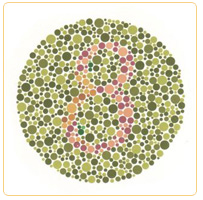Color Blindness

Color blindness is the inability to perceive differences between some of the colors that others can distinguish. The condition is sometimes called Daltonism. Problems may range from a slight difficulty in telling different shades of a color apart to not being able to identify any color. Though color blidness is most often of genetic nature, but may also occur because of eye, nerve, or brain damage, or due to exposure to certain chemicals.
The normal human retina contains two kinds of light cells: the rod cells (active in low light) and the cone cells (active in normal daylight). Normally, there are three kinds of cones, each containing a different pigment. The cones are activated when the pigments absorb light. When one or more of these types of cone cells is absent or fails to function properly, you may not see one of these three colors or you may see a variation of that color or a different color.
Red-green color deficiency is the most common form of color blindness; a less common form is blue-yellow color deficiency. Color blindness is more common in males than in females
Color blindness is usually classed as disability, but it is not a form of blindness. Anyone who has a job that requires identifying colors correctly should be tested for color vision deficiency. Any child who is having difficulty in school should be checked for vision problems including color vision deficiency. A color vision problem can have a significant impact on a person's life. Color vision problems may affect learning abilities and reading development and may limit a person's career choices. However, children and adults with color vision problems can learn to compensate for their inability to see colors.
Since color blindness is caused by a common X-linked recessive gene, genetic counselling is required for couples with a family history of color vision problems. If you're color-blind, your mother must either be color-blind or have normal vision but carry the color-deficient gene. Color-blind fathers pass the gene to their daughters only, who will have normal color vision unless their mother also carries the color-deficient gene.
It is estimated that 8% of males and less than 1% of females have color vision problems. Most color vision problems are hereditary and already present at birth.
Another cause for color vision deficiency is aging. The eye's clear lens can darken and yellow over time, which can cause older adults to have problems seeing dark colors. Certain medications or eye diseases can affect color vision.The symptoms of color vision problems vary with the severity of the condition. In some people the problem is very minor, and they may not even be aware that they see color differently from people with normal color vision. In other people the color vision problem is severe, and they can distinguish only a few shades. In rare cases, a person cannot see color at all but sees only black, white, and gray.

Tests are used to measure the ability to recognize different colors. Eye doctors use Ishihara plates to determine the severity and type of color deficiency. In this test, a person is asked to look at an arrangement of colored dots and identify a pattern, such as a letter or number. The type of color vision problem you have can often be determined by which patterns you can and can't see in the various plates used for the test. In red-green deficiency, the patient has trouble seeing the red among the green.
Inherited color vision problems cannot be treated or corrected. Some acquired color vision problems can be treated, depending on the cause. For example, if a cataract is causing a problem with color vision, surgery to remove the cataract may restore normal color vision.
Some people use special lenses for color blindness, which are filters available in either contact lens or eyeglass lens form. There are specially tinted eyeglasses that may help you to tell certain colors apart. A color blind person can also learn ways to work around his inability to pick out certain colors. For instance, he might organize and label his clothing to avoid color clashes.
Last Updated: October 23, 2024



























